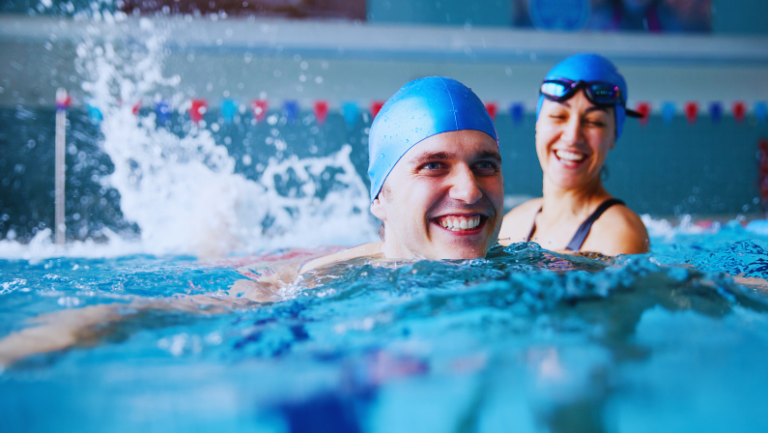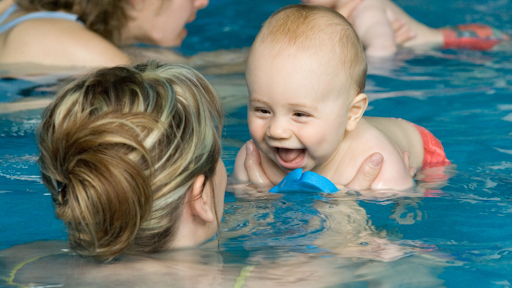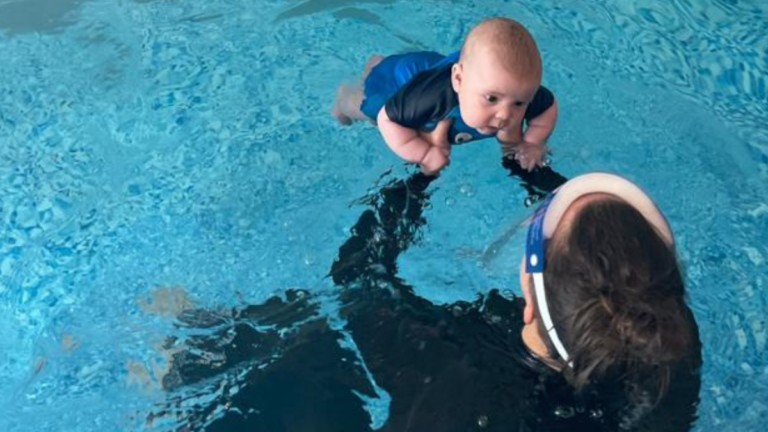Do you have a 3- or 4-year-old preschooler and wonder if now is the right time to start swimming lessons? You’re in the right place! We’ve gathered everything you need to know to help you decide whether swimming lessons are the right step for your little one. You can even follow a case study of Kaia, Cindy’s daughter at 3 years old, learning how to swim.
One thing is certain—swimming is a vital life skill. Starting early helps children build water confidence, develop safety awareness, and learn essential swimming techniques. Best of all, it’s lots of fun!
If you’re thinking about enrolling your preschooler in swimming lessons, here’s everything you need to know.
Frequently Asked Questions about Preschool Swimming Classes
Click the question to jump to our answer!
- Is 3 or 4 years old the right age to start swimming lessons?
- What stage should a 3 and 4-year-old be at in swimming?
- What will preschoolers learn during a swimming lesson?
- How can I help my 3 or 4-year-old become more confident during swimming lessons?
- Can I teach a preschooler to learn how to swim?
- How should you teach 3 and 4-year-olds to learn how to swim?
- Should my preschooler use flotation aids during lessons?
- What are some preschooler swimming games and songs?
- What are some swimming lesson plan ideas for 3 and 4-year-olds?
- What are the benefits of preschool swimming lessons?
- What should preschoolers wear during swimming lessons?
- Do I need to accompany my preschooler in the water during lessons?
Is 3 or 4 years old the Right Age to Start Swimming Lessons?
Yes! Ages 3 and 4 are a great time to start structured swimming lessons. At this stage, children develop motor skills, coordination, and confidence in the water. Early swimming lessons also promote water safety and lay the foundation for future swimming proficiency.
What Stage Should a 3 and 4-Year-Old Be at in Swimming?
At this age, most children are beginners in swimming. They should be developing basic water confidence, learning to float, kick, and control their breath. Some preschoolers may already feel comfortable putting their faces in the water, while others are still getting used to splashing and moving around.
At Cindy’s, our preschoolers follow our Learn to Swim Programme. Their first goal is to swim 5 metres with a noodle to earn their 5-metre badge before progressing to their Stage 1 Certificate.
You can follow one of our young swimmers, 3-year-old Kaia, on her journey to Stage 1. Watch as she builds confidence and masters new skills like jumping in, floating on her back, and even diving!
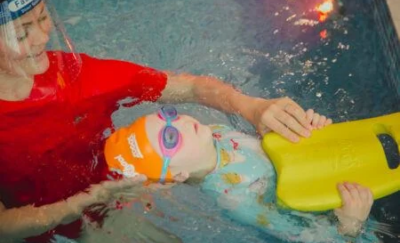
See Kaia's swimming journey
See videos and images of what 3-year old-swimming lessons are really like! Cindy and Mark’s daughter makes her way through the pre-school swimming stage.
Kaia has been swimming since she was a newborn and is very confident in the water. However, every child progresses at their own pace. No matter their starting point, building water confidence is something all preschoolers can enjoy and benefit from.
What Will Preschoolers Learn During a Swimming Lesson?
The main goal for preschoolers during our swimming lessons is to help each child build confidence and independence in the water. Our lessons are a mix between fun and learning. Some skills they learn include:
- Entering and exiting the pool safely
- Water confidence and safety
- Getting used to water submersion and blowing bubbles.
- Floating like a starfish on their front and back. Firstly with a noodle or with help from a teacher and then as unaided as possible.
- Jumping into the water!
- Basic stroke technique
- Swimming 5 metres on front and back. Firstly with a noodle and then as unaided as possible.
You can see exactly what they learn during stage 1 here.
How Can I Help My 3 or 4-Year-Old Become More Confident During Swimming Lessons?
Encourage playtime in the water outside of lessons. Take them swimming with you separate to their lessons. Enjoy playing and having fun. Participating in water activities together helps build their confidence. This could include simple games like splashing, practicing floating, or gently guiding them through the water. You can also have a go at practising what they learn in their swimming lessons.
Use positive reinforcement and praise. Celebrate the small achievements as well as the big ones. Cheer when they blowing bubbles or floating for a few seconds.
Stay patient and avoid pressure. Every child progresses at their own pace, so let them take their time.
Can I Teach a Preschooler to Learn How to Swim?
Yes, it certainly is possible to teach a preschooler to learn how to swim. However, we would recommed swimming lessons as the best course of action for two reasons.
Firstly, our swimming instructors are trained in the best ways to teach swimming to young children, they have lots of experience and love teaching little ones how to swim.
Secondly, teaching your own children to swim is hard! Some children will cling to mum or dad for all they’re worth. Others will test their parent’s patience more than they would dare with a formal teacher. It takes training to maintain an objective teaching approach, especially with your own children.
The best thing parents can do is support their child’s learning by taking them swimming regularly outside of swimming lessons. Then you can concentrate on having fun with your child in the pool, without the stress of teaching them. Ir’s a great time to practice floating and kicking with fun water activities. You can also reinforce basic water safety rules.
The other advantage of swimming lessons at Cindy’s Swim School is you get to be part of our amazing swimming community. Kids can make friends, earn badges as they progress and take part in our annual gala.
Why not pick up our stage 1 to 3 Starter Swim Kit (featured below) to support your child when you take them swimming?
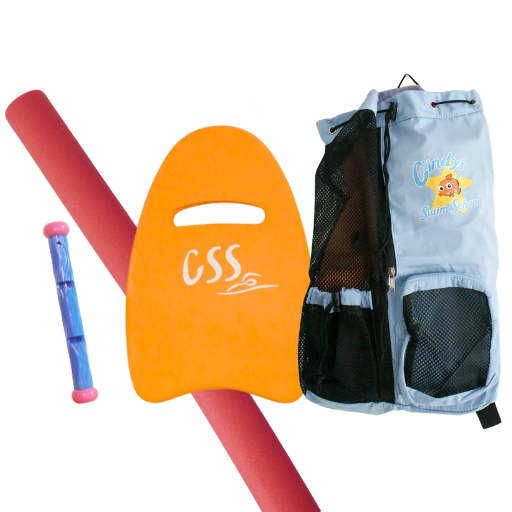
Stage 1 to 3 Starter Swim Kit
Our Junior Stage 1-3 Kit contains a pool noodle (woggle), a diving sinker, and junior kickboard all neatly stored in a swim bag in a colour of your choice.
£40.00
How Should You Teach 3 and 4-Year-Olds to Learn How to Swim?
If you do decide you want to teach your preschooler to swim or want to supplement their swimming lessons, here’s a breakdown of helpful steps:
Start with water play to build confidence. Start with simple water play. This could even begin in the bath at home or sitting on the side of the pool. The goal is to get them comfortable with the sensation of water on their skin and around their faces, reducing any potential fear or anxiety. Play some water games, sprinkle water on their faces, blow bubbles in the water and make it fun!
Teach floating and kicking before introducing strokes. Before introducing complex swim strokes, focus on the fundamentals: floating and kicking. Start by teaching them how to float on their backs. You can support them gently, gradually reducing your assistance as they gain confidence. For kicking, have them hold onto the side of the pool or a kickboard while practicing their leg movements. Make sure they understand the importance of a strong and consistent kick for propulsion.
Use songs and games to make lessons fun. Young children learn best through play. Incorporate songs, rhymes, and water games into your lessons.
Keep instructions simple and repetitive. Preschoolers have short attention spans. Give simple, easy-to-understand instructions. Repetition is key. Repeat instructions and demonstrate the movements multiple times. Be patient and understanding if they don’t get it right away.
Provide plenty of encouragement and reassurance. Positive reinforcement is crucial. Offer plenty of praise and encouragement for even the smallest achievements. If they’re struggling or feeling scared, reassure them that it’s okay and that they’re doing great.
Should My Preschooler Use Flotation Aids During Lessons?
Water safety is a top priority in our lessons, which is why we avoid using armbands and similar flotation devices. These can give young children a false sense of buoyancy, making them believe they can float unaided when they actually cannot.
To ensure they develop real water confidence and essential safety skills, we use noodles and kickboards instead. These provide support only when necessary, and they strengthen balance skills, helping children learn to move through the water safely and independently.
What Are Some Preschooler Swimming Games and Songs?
There are plenty of songs and games you can use to make swimming for preschoolers fun. Here are some ideas:
Humpty Dumpty: This is a great game to increase children’s confidence when getting into the water. Kids sit or stand on the pool edge, sing the rhyme, and then are either lifted into the water, jump in or are caught by an adult.
How Many Fingers?: Play this game in shallow water with your child wearing goggles. They start by taking a deep breath, looking down from the water’s surface, and counting the number of fingers you hold underwater. Gradually increase the difficulty by having them fully submerge their face and head before counting the fingers.
Car Wash: this is a good game to help you child get used to having water on their face. Preschoolers move through the water with an adult and have water sprinkled on their face (pretending they are a car at the car wash). You can move onto blowing bubbles and finally submerging their face into the water..
Horse Race: Children can sit on a noodle like they are pretending to ride a horse and move through the water. This can be done independently or with an adult.
What Are Some Swimming Lesson Plan Ideas for 3 and 4-Year-Olds?
If you want some ideas for planning swimming lessons for your child here are some simple suggestions:
Floating games to develop balance: pretend to be a starfish or float like a jellyfish.
Blowing bubbles for breath control: turn part of the lesson it into a fun game of who can blow the most bubbles.
Practicing safe entries and exits: jump in with assistance or climb out using the poolside. When they become more confident have a fun jumping session at the end of your lesson as a reward for their progress.
Using noodles for independent movement: let them pretend they are riding a horse or spaceship.
What Are the Benefits of Preschool Swimming Lessons?
Taking preschoolers swimmming has so many benefits, the question is why would you not want to do it?
Develops motor skills and coordination
Swimming requires whole-body movement, helping to strengthen muscles, improve balance, and enhance coordination. Developing thse skills is also beneficial if they want to do other sports and activities.
Encourages social skills and listening
Group swimming lessons provide opportunities for preschoolers to interact with peers, practice listening, follow instructions, and develop patience and teamwork.
Improves numeracy and literacy
Amazingly, young swimmers perform ahead of their peers in numeracy and literacy tests, as demonstrated by Griffith University in Australia, probably due to the regular use of counting, rhymes and songs in early years swimming.
Supports physical fitness
Swimming is an excellent full-body exercise that promotes endurance, flexibility, and cardiovascular health in young children.
Reduces fear of water
Familiarity with water at an early age can help prevent fear and anxiety, making future swimming experiences more enjoyable and stress-free. And of course, water safety skills can ultimately be life-saving!
Boosts independence and confidence
What Should Preschoolers Wear During Swimming Lessons?
A comfortable, well-fitted swimsuit or trunks.
Goggles – which we sell – just ask the office!
A swim cap – children will be given a CSS cap when you join our Children’s Learn To Swim Programme.
A swim nappy if needed – At Cindy’s we require a swim nappy and a neoprene swim nappy, which goes over the swim nappy ensuring there are no accidents in the pool!
Do I Need to Accompany My Preschooler in the Water During Lessons?
At Cindy’s, parents can accompany children during swim lessons until the age of 3.5 years old or they can start with the teacher n the pool.
We offer classes with a 2:1 and 4:1 teacher to pupil ratio lesson for preschoolers. Parents and carers can stay at the side of the pool during lessons.
Ready to get started? Contact us at Cindy’s today to ask any questions and book your preschool swimming class.

